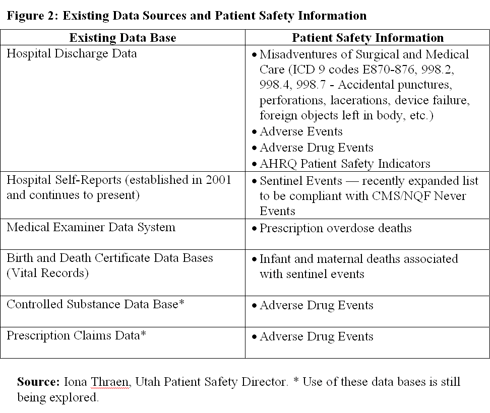Utah is pursuing a two-pronged strategy to reduce adverse events and medical errors: leveraging existing data collection efforts to identify adverse events and providing feedback to health care providers. The state is partnering with the Utah Hospital Association, Utah Medical Association, Health Insight (the Medicare quality improvement organization for Nevada and Utah), and hospital system representatives.
Public health department staff are planning to use existing surveillance mechanisms to identify patient safety issues (Figure 2). For example, the perinatal program conducts medical chart reviews on the deaths of mothers and babies during the first year after delivery. Patient safety director Iona Thraen wants to refine and expand this review to identify trends in medical errors and other preventable adverse events. "We want to learn how to use already existing mechanisms to make better tools, and then feed back the information to patient safety personnel at the hospitals."

Rather than making information on adverse events public, Utah provides direct feedback to their health care industry partners. These partners, in turn, are asked to develop interventions to address identified problems. There are three user groups: one focuses on "sentinel events," also known as "never events," (e.g., wrong-site surgeries and pressure sores), one focuses on adverse drug events, and the third focuses on health facility–acquired infections. The groups examine trends, define "rule sets" that codify recommended practices and procedures, and promote implementation of these rules among their colleagues.
Utah has followed a similar, collaborative approach in its Correct Site Surgery Initiative. Data on wrong-site surgeries revealed that, across hospitals, there were 12 different methods of marking a surgery site. The Department of Health joined with hospital and physician groups to build a set of standards. All of the hospitals in the state signed letters of agreement to adopt the standards, which were then sent out with license renewal notifications to about 8,000 physicians. Evidence indicates a downward trend in wrong-site surgeries since this intervention.
"The effort of building a culture of safety is still in its infancy, and we must move cautiously but progressively," says Thraen. "We're beginning by bringing hospitals to the table, and getting them comfortable with talking openly to one another about very sensitive and critical issues without violating peer review protection, patient confidentiality, and privacy." The sentinel events group, for example, is just beginning the conversation on how and when to disclose the occurrence of a medical error to families, and how recently passed "I'm Sorry" legislation might affect disclosure. [5]
Utah must still work to secure stable financing. Current funding for patient safety activities within the Department of Health is quite modest—a proposed $200,000 per year for two staff members. Also, according to Thraen, a significant challenge going forward is, "to shift from a legal and cultural 'blame focus' to a 'system improvement focus.' Professionals have to feel safe. This takes education, infrastructure, time, and political will."
|